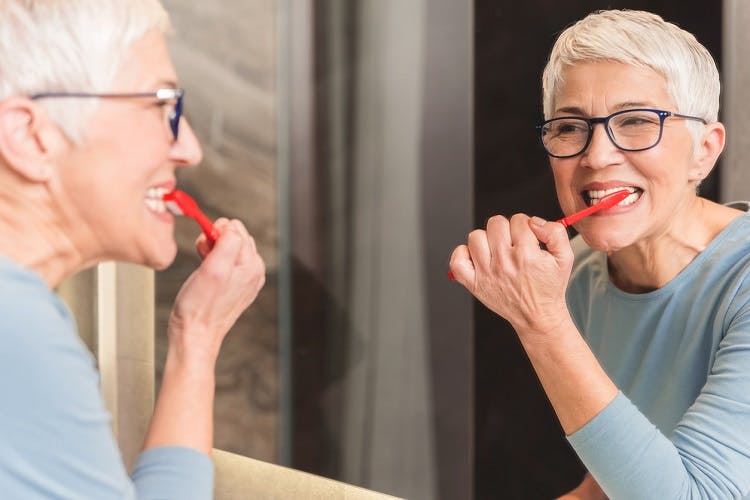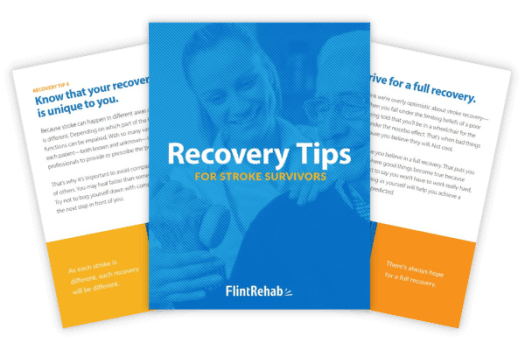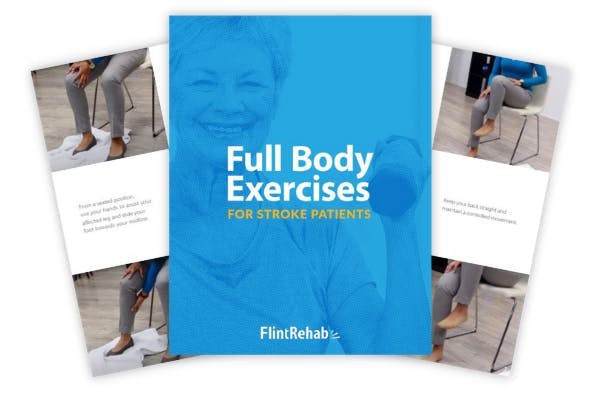No products in the cart.
No products in the cart.
No products in the cart.
No products in the cart.
Home » Neurological Recovery Blog » Stroke » Activities of Daily Living After Stroke: How to Regain Your Independence
Last updated on January 9, 2024

After stroke, many different aspects of a survivor’s life can be affected, including the activities of daily living. The activities of daily living are the basics of self-care. These involve tasks oriented towards taking care of one’s own body and enabling basic survival and well-being.
These activities include feeding, bathing, dressing, grooming, toileting, functional mobility, and other more complex tasks. After a stroke, survivors may struggle with these activities of daily living, indicating a critical need for rehabilitation to boost independence. This independence is the ultimate goal that your therapists are there to help you with.
In this article, we will review the different activities of daily living that may be affected after stroke. Additionally, we will discuss stroke rehabilitation as it pertains to relearning these activities. Feel free to use the links below to jump straight to any section:
During rehabilitation, you will likely hear many therapy terms thrown around by your healthcare team. One of these terms is “activities of daily living,” or ADLs. This term is fairly self-explanatory as it refers to the important self-care tasks most individuals perform every day. Let’s begin by reviewing some of these different self-care activities:
IADLs are generally more complicated than basic activities of daily living and can seem even more daunting after stroke. As you can imagine, the secondary effects of stroke can make these tasks extremely challenging, which can limit a survivor’s independence. However, there is hope to improve function through dedicated rehabilitation.
To relearn activities of daily living after stroke, it is necessary to participate in rehabilitative therapies. Rehabilitation after stroke revolves around the concept of neuroplasticity, which refers to the brain’s ability to reorganize itself based on experiences. This is how we learn new skills and, particularly after stroke, relearn impaired skills such as the activities of daily living.
Through neuroplasticity, the brain can rewire important neural connections from areas of the brain affected by stroke to healthy, unaffected areas. The most effective way to promote neuroplasticity is through highly repetitive and task-specific practice. This stimulates the brain and reinforces demand for those functions.
For example, your occupational therapist may help you practice cutting putty with utensils to simulate cutting food in preparation for eating. When practiced on a regular basis, this experience helps stimulate the brain and improve your ability to use utensils. With time, you can then carry this skill over to the task of self-feeding.
If you struggle with the activities of daily living after stroke, it’s likely that you will work closely with a team of therapists. These therapists will help you improve your self-sufficiency and independence with ADLs and IADLs. Next, we’ll look at two specific types of therapy that help improve your independence with your daily activities.
Regaining the ability to perform the activities of daily living after stroke involves intensive participation in occupational therapy (OT) and physical therapy (PT). Additionally, participation in speech therapy, if indicated for you, can help with ADLs. Your therapy team will be able to help you identify your unique needs, create goals for recovery, and develop a plan to reach those goals.
Occupational therapy helps individuals learn how to be functional and independent by focusing on activities of daily living after stroke. Practicing ADLs is helpful because they provide direct, task-specific applications to the real world. This helps survivors prepare for the transition back to everyday life.
Physical therapy focuses on improving functional mobility through targeted exercises. By working on balance, strengthening the muscles, and promoting full range of motion at physical therapy, individuals can perform activities of daily living with greater ease.
Speech therapy is another valuable piece of the rehabilitation plan for many survivors. Your speech-language pathologist, or speech therapist, can help you improve skills such as attention, memory, and good judgment to engage in these tasks safely. Additionally, speech therapy is crucial for survivors affected by dysphagia, or difficulty swallowing after stroke, to improve feeding.
All these rehabilitative therapies help individuals relearn activities of daily living. Furthermore, it is beneficial to perform these types of therapy in conjunction with one another. Rehabilitation after stroke is most effective when it is viewed as a team-based approach. Fortunately, this is often what happens during the early stages of the stroke recovery timeline.
After a stroke, many survivors spend time at an inpatient rehab facility. During their inpatient stay, they spend 3+ hours per day doing PT, OT, and possibly speech therapy. After discharge from inpatient rehab, therapy often continues with outpatient rehab, home health therapy, or simply a home exercise program.
The brain requires consistent stimulation and experience to rewire itself. Therefore, it’s imperative for stroke survivors to continue with dedicated rehabilitation at home. Practicing therapeutic exercises daily can help feed the brain the stimulation it needs to strengthen essential functions, such as the activities of daily living.
Depending on the severity of a survivor’s motor impairments, the techniques used to relearn activities of daily living after stroke will vary. Your therapy team will be able to recommend the most effective treatment methods to help you gain function and independence. Below, we’ll discuss some of the rehabilitative techniques you may encounter to improve your performance of the activities of daily living after stroke.
Sometimes, secondary effects of stroke like dysphagia impair motor control over the oral muscles. This can affect a survivor’s ability to chew and swallow, contributing to other complications including malnutrition or aspiration pneumonia. Working with a speech-language pathologist to practice speech therapy exercises can help strengthen the muscles needed for chewing and swallowing.
Paralysis of the arm after stroke can also affect the ability to eat. While it may be easier to just use the unaffected arm to feed yourself, it’s essential to practice tasks with your affected arm. This promotes recovery and helps survivors avoid learned nonuse. To encourage you to use your affected arm to eat after a stroke, an occupational therapist may teach you how to use adaptive utensils. This type of adaptive equipment can help compensate for limited grip or control over the wrist.
Practicing good hygiene after a stroke can be difficult. Due to hemiplegia or hemiparesis (paralysis or weakness of one side), individuals have an increased risk of falling in the shower. Your occupational therapist will help you practice bathing and getting in and out of a shower during therapy. During practice, they will also teach you how to be safer and more independent with this task.
Another way to promote increased safety is to install grab bars and seats in the shower. Additionally, placing a rubber mat in the shower helps make the floor less slippery. Your occupational therapist can recommend the appropriate equipment to make your home as safe as possible.
Working with your physical therapist to practice stroke rehab exercises can help improve functional mobility. As you regain strength and control, getting in and out of the bath or shower will become easier. Additionally, your therapist will help you with balance exercises to reduce your risk of falling in the shower.
Survivors with paralysis or weakness after a stroke may struggle to get dressed. Tasks like buttoning a shirt, pulling up a zipper, and hooking a bra require fine motor skills. Similarly, putting on pants generally requires balance skills that survivors may find challenging.
An occupational therapist can teach you strategies to improve your ability to independently dress yourself, some of which may be compensatory strategies. For example, you may learn how to put your pants on while lying in bed or how to use adaptive tools like button hooks and zipper pulls. Additionally, through hand therapy exercises your OT can help you improve your fine motor control.
Some stroke survivors may be able to get dressed without utilizing compensatory strategies. However, due to weakness, they often require more time, assistance, or supervision to do so. Continuing to practice getting dressed independently can help strengthen motor skills and gradually increase speed.
Likewise, a physical therapist can guide stroke survivors through exercises that will help restore motor control and increase balance on their affected side. Both approaches can help survivors be more independent with the task of getting dressed.
If a stroke causes leg paralysis or weakness, survivors may have to use mobility aids like walkers, canes, or wheelchairs. At occupational therapy, survivors may practice techniques to help them get in and out of bed. It will also be important to practice transferring to and from wheelchairs, toilets, and showers in a safe manner. Installing grab bars can help provide a stable surface to hold while performing transfers, although this is not appropriate for everyone.
Generally, independent functional mobility requires increased dependence on the legs, core, and arms. To make transfers and other types of functional mobility easier to perform, a physical therapist may have you practice strengthening, bed mobility, and sitting balance exercises. Physical therapists can also help you practice walking to make you more mobile and independent in your home and community.
Impaired gross and fine motor control following a stroke may make everyday grooming tasks extremely challenging. For example, turning the faucet on and off, squeezing products onto your palms, and gripping your brush may feel impossible.
An occupational therapist can work with you on improving your arm and hand strength and coordination to increase your independence with grooming tasks. Additionally, when appropriate, they may have you use an adaptive tool called a universal cuff to help you grip items. Your OT may also recommend using an electric toothbrush to clean your teeth more effectively.
After a stroke, some individuals have difficulty controlling their bladder and bowels. This condition, known as incontinence, can have a major impact on a survivor’s quality of life. To help with this, your occupational therapist may suggest following a bowel and bladder management program. This involves sticking to a schedule and performing the same toileting tasks at around the same time every day. By doing this, survivors can better predict when they should empty their bowels to help prevent accidents.
A specially trained PT, called a pelvic floor therapist, can also work with you to help reduce incontinence. They can address tightness or spasticity in your pelvic floor muscles and help you with urgency control. Your PT can also provide specific exercises for your core and pelvic floor to address incontinence. Furthermore, your OT can help you practice pulling your pants up and down and performing hygiene after using the toilet.
Strokes are complex, and every recovery will look different. For some, the activities of daily living can seem daunting or impossible after stroke. However, there is always hope for increasing your function and independence. The best way to recover from a stroke is repetitive practice of the skills you want to rebuild.
Practicing speech therapy exercises can help you regain control of your oral muscles and improve feeding skills. Occupational therapists can help you choose adaptive equipment and find strategies to make ADLs like feeding more accessible. Similarly, physical therapy can help you improve your functional mobility and address incontinence. This is just a small piece of what different therapies can do for you after stroke, but this improvement takes commitment and consistency.
By repetitively practicing exercises and engaging in basic self-care tasks, you can relearn activities of daily living after stroke. The more you practice, the more you can feel empowered and independent. With time, improving your performance of the activities of daily living can improve your quality of life and help you get back to doing the things you enjoy most.

Get our free stroke recovery ebook by signing up below! It contains 15 tips every stroke survivor and caregiver must know. You’ll also receive our weekly Monday newsletter that contains 5 articles on stroke recovery. We will never sell your email address, and we never spam. That we promise.


Do you have these 25 pages of rehab exercises?
Get a free copy of our ebook Full Body Exercises for Stroke Patients. Click here to get instant access.
“My name is Monica Davis but the person who is using the FitMi is my husband, Jerry. I first came across FitMi on Facebook. I pondered it for nearly a year. In that time, he had PT, OT and Speech therapy, as well as vision therapy.
I got a little more serious about ordering the FitMi when that all ended 7 months after his stroke. I wish I hadn’t waited to order it. He enjoys it and it is quite a workout!
He loves it when he levels up and gets WOO HOOs! It is a wonderful product! His stroke has affected his left side. Quick medical attention, therapy and FitMi have helped him tremendously!”
FitMi is like your own personal therapist encouraging you to accomplish the high repetition of exercise needed to improve.
When you beat your high score or unlock a new exercise, FitMi provides a little “woo hoo!” as auditory feedback. It’s oddly satisfying and helps motivate you to keep up the great work.
In Jerry’s photo below, you can see him with the FitMi pucks below his feet for one of the leg exercises:
Many therapists recommend using FitMi at home between outpatient therapy visits and they are amazed by how much faster patients improve when using it.
It’s no surprise why over 14,000 OTs voted for FitMi as “Best of Show” at the annual AOTA conference; and why the #1 rehabilitation hospital in America, Shirley Ryan Ability Lab, uses FitMi with their patients.
This award-winning home therapy device is the perfect way to continue recovery from home. Read more stories and reviews by clicking the button below:
Grab a free rehab exercise ebook!
Sign up to receive a free PDF ebook with recovery exercises for stroke, traumatic brain injury, or spinal cord injury below: